Ijraset Journal For Research in Applied Science and Engineering Technology
- Home / Ijraset
- On This Page
- Abstract
- Introduction
- Conclusion
- References
- Copyright
Fabric Default Detection Using CNN
Authors: Jyothi M R, Dr. M Prasad
DOI Link: https://doi.org/10.22214/ijraset.2022.45356
Certificate: View Certificate
Abstract
Fabric fault detection is very popular in textile industry where quality maintenance becomes a prominent feature, this paper provides an survey of automatic fabric fault detection approaches that have been developed in recent day. Common types of fabric defects are used to evaluate the performance of the projected idea Moreover detection methods were also evaluated in real time using a model automation specification evaluate. This research paper will be useful for both researchers and practitioners in the field of image depuration and computer vision to understand the uniqueness of the different defect detection methods. The recognition receives a digital fabric image from the image acquisition device and transforms it to a binary image using the restoration and threshold methods. This research presents a fashion that decreases manual work. This image processing method will be performed using CNN. Therefore, this study uses a textile fault detector with a systematic creativity approach for image processing.
Introduction
I. INTRODUCTION
Automatic defect detection is a challenging task because of the flexibility in texture and type of fabric defects. An actual defect detection system enables manufacturers to improve the quality of processes and products. Automation across the textile manufacturing systems would decrease fabric wastage and increase profitability by saving cost and resources. There are unlike contemporary research on automatic defect detection systems using image processing and machine learning techniques. These techniques differ from each other based on the produce processes and defect types. Researchers have also been able to begin real-time defect detection system during weaving.
At the stage of production Automatic inspection of stained cloth has been an admirable research topic in manufacturing and quality control for over twenty years. It aims to identify and paint defects on the surface of stained fabric which was previously done by workers but it led to human errors, high labor cost and slow process thus, an improved Automatic vision improves the monitoring of such controls and provides high detection accuracy for quality control in the textile assembly. To overcome these hindrances, a system of image processing is employed using CNN. A smooth fabric is taken as an input sample and roughness and any tear will be considered as defects and will be observed.
Some common defects occur are discussed below:
- Yarn defects
- Weaving defects
Applications of artificial intelligence techniques can offer a low-cost and high-efficiency for decision-making in many domains. Consequently, advanced detection technologies, which can be integrated into the existing fabric inspection machine, are in increasing demand. Moreover, with the continued development of the textile fabrication, the texture of fabric has become more and more complex and diverse. With the improvement of waving technology, inconspicuous and small defects in fabric have become more and more common, which makes the detection task more challenging. Consequently, the research of developing a robust model with high accuracy and efficiency for defect detection has great significance. This paper proposes a novel framework for fabric defect detection-based convolutional neural networks (CNNs).
A. Problem Statement
One of the important sectors of Indian Economy is textile industry. Over the last two years, fabric defect detection by means of image processing has received considerable attention. Any defects in the fabric will directly decrease the quality of the product and thereby has its effects on the economy thus it becomes important to have an automated quality check for the defects.
B. Objectives
Based on literature survey conducted the objectives concluded are:
- Acquisition of fabric images.
- Recognize and detect the defects in the fabric.
C. Proposed System
Solving a problem by creating an automatic system for detecting the defects in the fabrics using image processing techniques will not only save the time and cost of labour but also proposes a smart way of detecting fabric defects. We propose the automatic detection of defect in the fabric using deep learning.
II. LITERATURE SURVEY
A. Kumar and G. K. H. Pang et al. [1], various approaches for automated inspection of textured materials using Gabor wavelet features. A new direct defect detection approach to detect a class of defects in textile webs is proposed. Unsupervised web inspection using multichannel filtering scheme is investigated. A new data fusion scheme to multiplex the information from the different channels is proposed. Various factors interacting the tradeoff for performance and computational load are discussed. This scheme establishes high computational savings over the previously proposed approaches and results in high quality of defect detection. Final acceptance of visual inspection systems depends on economical aspects as well.
W. K. Wong and J. L. Jiang et al. [2] wrote a book Applications of Computer Vision in Fashion and Textiles provides a systematic and comprehensive discussion of three key areas that are taking dominance of developments in computer vision technology, namely textile defect detection and quality control, fashion identification and 3D modeling, and 2D and 3D human body modeling for improving clothing well. It introduces the basic of computer vision techniques for fashion and textile applications, also reviewing computer vision techniques for textile class control, including chapters on wavelet transforms, Gibor filters, Fourier transforms, and neural network techniques. Final sections cover recognition, modeling, retrieval technologies and advanced human shape modeling techniques.
A. Kumar et al. [3] presents the first survey on fabric defect detection techniques presented in about 160 references. Classification of fabric defect detection techniques is useful in evaluating the qualities of identified features. The characterization of real fabric aspect using their structure and primitive set has not yet been successful. Therefore, on the basis of the creation of features from the fabric aspect, the proposed approaches have been characterized into three categories; statistical, spectral and type-based. In order to evaluate the state-of-the-art, the limitations of several promising techniques are recognition and performances are analyzed in the context of their demonstrated results and intended exercise. The conclusions from their work also suggest that the combination of statistical, spectral and model-based approaches can give better results than any single approach, and is suggested for further exploration.
O. Essid, H. Laga, and C. Samir et al. [4] developed a new machine vision framework for efficient detection and classification of manufacturing defects in metal boxes. Previous techniques, which are based on either visual inspection or on hand-crafted features, are both inaccurate and time consuming. They show that by using auto-encoder deep neural network (DNN) architecture, we are able to not only classify manufacturing defects, but also localize them with high accuracy. Compared to traditional techniques, DNNs are able to learn, in a supervised manner, the visual features that achieve the best performance.
Their experiments on a database of real images demonstrate that our approach overcomes the state-of-the-art while remaining computationally competitive. R. Furferi and L. Governi et al. [5] developed system for real-time detection and classification of defects on textile raw fabrics. The device(software + hardware) is directly attached to an appositely developed appraisal equipment machine (weave room monitoring system) and the inspection is discharge online. The developed device performs (1) the image acquisition of the raw fabric, (2) the extraction of some critical parameters from the acquired images, (3) an artificial neural network (ANN)-based approach able to detect and classify the most frequently occurring types of defects occurring on the raw fabric and (4) a standard image processing algorithm that allows the measurement of the geometric properties of the detected defects.
W. Ouyang, B. Xu, J. Hou, and X. Yuan et al. [6] developed a deep-learning algorithm for an on-loom fabric defect inspection system by combining the approach of image pre-processing, fabric motif determination, candidate defect map generation, and convolutional neural networks (CNNs). A novel pairwise-potential activation layer was introduced to a CNN, leading to high validity of defect segmentation on fabrics with intricate features and imbalanced dataset.
o.Russakovsky, et al. [7] J. Deng, H. Su, J. Krause, S. Satheesh,S. Ma, Z.Huang, A. Karpathy, A. Khosla, M. Bernstein “ImageNet Large Scale Visual Recognition Challenge” (2019) In this paper we described the large-scale data collection process of ILSVRC, provided a summary of the most fortunate algorithms on this data, and analyzed the success and failure modes of these algorithms.
Kaiming He, XiangyuZhang, Shaoqing Ren, Jian Sun et al. [8] “Deep Residual Learning for Image accept” (2015).
Above method has good generalization performance on other recognition tasks.
Table 7 and 8 show the object detection baseline reaction on PASCAL VOC 2007 and 2012 [5] and COCO [26]. We adopt Faster R-CNN [32] as the detection routine. Here we are interestedin the improvements of replacing VGG-16 with ResNet-101.
M. Artuso and H. Christian et al. [9] “Optimizing TCP for Cloud Based MobileNetworks” (2016). In this paper, the proposed routine has achieved a high accuracy in classifying the images. We have implemented the convolutional neural network using Tensor Flow. It has been shown that classifier performs well in terms of classification accuracy. However, we use a CPU based system, so experiment has taken extra training time, if we would have used a GPU based system, the training time would have been less. This model can be applied for solving complex image classification problem related to medical imaging and other fields.
Dr.M Prasad et al. [10] Facial expressions are the important and successful requirement in image analysis in the field of image processing. Facial expressions are mainly based on mouth and eye for analyzing and recognizing the human mood. Many segmentation techniques are available for to analyze and recognize the facial declaration based on human mood. The main aim of facial expressions is to recognize the facial features such as mouth and eye from an given input facial image.
III. SYSTEM DESIGN
A. System Architecture
The figure 1 depicts the architectural diagram of proposed system. System design the main aim of this structure incorporated in study can fetch out data from economic news and propose this sets into prognosticate model. Major phases in formulated system include data collection and pre-processing, feature and factor selection and price appraisal and prediction CNN is a type of neural network which is widely used in the computer vision domain. It has proved to be highly effective such that it has become the go-to method for most image data.
CNNs consist of a minimum of one convolutional layer which is the first layer and is responsible for feature extraction from the image. CNNs perform feature extraction using convolutional clear on the input and analysing some parts of the input at a given time in front sending the output to the subsequent covering. The convolutional layer, through the use of convolutional filters, generates what is called a feature map. With the help of a pooling layer, the dimensionality is reduced, which reduces the training time and prevents over-fitting. The most common pooling layer used is max pooling, which takes the greatest value in the pooling window.
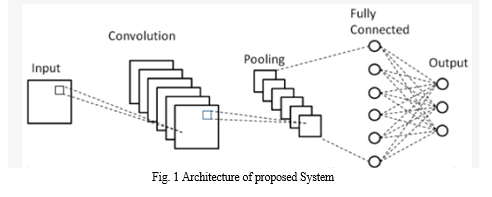
B. Dataflow Diagram
Figure 2 depicts DFD is also called as bubble chart. It is a simple graphical formalism that can be used to constitute a system in terms of input data to the system, various processing carried out on this data, and the output data is generated by this manner.
Training phase: A set of labelled Fabric images is pre-processed for ROI extraction and segmentation. The training phase can be summarized as follows:
- Extract features such as Texture, Shape and Area. from the pre-processed images.
- Train a CNN classifier using this feature set.
The output of the training phase is a trained classifier capable of predicting classification label based on features of Fabric with default and non-default..
The performance of the trained classifier can be evaluated using measures like accuracy, sensitivity and specificity.
Classification:
This phase can be summarized as follows:
a. Take as input, Fabric image.
b. Pre-process the Image.
c. Extract the required features from the uploaded fabric image.
d. Use the trained classifier to predict the Fabric whether it is default or not.
The output of this phase is a uploaded Fabric image with predicted result.
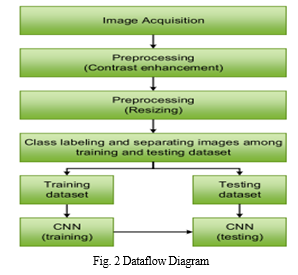
C. Activity Diagram
Figure 3 represents Activity diagrams are graphical representations of workflows of stepwise activities and actions with support for choice, iteration and concurrency. In the combine Modeling Language, activity diagrams can be used to describe the business and operational step-by-step workflows of components in a system. An activity diagram shows the overall flow of control.
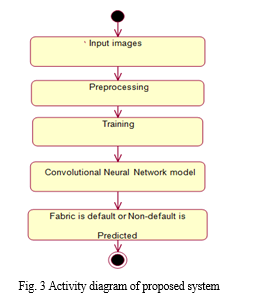
IV. IMPLEMENTATION
A. Methodology Of Proposed System
Our work is divided into 4 modules namely,
- Data collection
- Data preprocessing
- Model building
- Predicting
- Data Collection: Deep Learning depends heavily on data, without data, a machine can't learn. It is the most crucial aspect that makes neural network training possible. In Deep Learning projects, we need a training data set. It is the actual data set used to train the model for performing various actions.
Dataset- Aitex Fabric Image Database
The textile fabric database consists of 245 images of 7 different fabrics. There are 140 defect-free images, 20 for each set of fabric. With different sets of defects, there are 105 images. Images have a bulk of 4096×256 pixels. Defective images have been display as follows: nnnn_ddd_ff.png, site nnnn is the image digit, ddd is the defect code, and ff is the fabric code.
Defect free images have been control as follows:
nnnn_000_ff.png, where defect code has been restore by 0000 code.
2. Data Preprocessing: Data Pre-processing includes the following main tasks
3. Import The Libraries: The first step is usually importing the libraries that will be needed in the program. The required libraries to be imported to Python script are:
Numpy: It is an open-source numerical Python library. It contains a multi-dimensional array and matrix data structures. It can be used to perform mathematical operations on arrays such as trigonometric, statistical, and algebraic routines.
Pandas- It is a fast, powerful, flexible, and easy to use open-source data analysis and manipulation tool, built on top of the Python programming language.
Matplotlib- Visualization with python. It is a comprehensive library for creating static, animated, and interactive visualizations in Python.
4. Model Building: We build the trained CNN model by splitting the dataset in training and testing and is saved and its accuracy is calculated for performance analysis.
5. Predicting: We upload the test image and compared with the trained model for prediction of the fabric defectiveness.
B. Algorithm
Convolutional Neural Networks(CNN)
The planning of the prefer CNN have used for the categorization of the defected fabrics. This model is inspired by the AlexNet architecture, which consists of six convolutional layers each followed by a Rectified Linear Unit (ReLU), three max-pooling layers, and two dense or fully-connected layers last layer acting as an output layer with a Softmax activation function.
A flatten acting as a hidden layer is used to convert the images in a 1D array, thus enhancing the performance and making it simpler to handle the data. The bulk of each convolutional layer is 3×3 and each max-pooling is 2×2, whereas the size of the input images and feature maps varies shown in the figure. Stochastic gradient descent (SGD) or Backpropagation algorithm (BPA) is used for the training of the CNN.
The input volume is convolve with weights volume. Depending on the padding and out striding the input layer is expanded or shrinked. In the convolution process the spatial width and height is reduced, but increasing the depth. Non-linear activation function is added to each layer for modelling the more complex target function varying in a non-linear way with the given input. ReLU reduces the probability of a vanishing gradient.
This also introduces sparsity to the model. Pooling helps in reducing computational requirement and spatial size of the activation function. Max pooling due to higher convergence and better performance is more commonly used. The images are down sampled using max-pooling layer. It also reduces the likelihood of overfitting. Dense or fully connected layer is the final layer responsible for predicting the class of an image. Further details of the proposed multilayer convolutional neural network are given as:
- This model is a sequential model having a series of layers to convert the standard size image into a feature set for further processing.
- The first two layers of this model M are the convolutional layer with 128 filters and ReLU as the activation function.
- The third layer is the max pooling layer that will reduce the size of the convoluted image by (2, 2).
- It again adds two more convolutional layers will 256 filters and ReLU as the activation function.
- The sixth layer is the max pooling layer with a pool size of (2, 2).
- A convolutional layer with 384 filters and ReLU activation function is added to the model.
- The next layer is again a convolutional layer with 256 filters and ReLU activation function.
- Then it has a max pooling layer followed by dropout rate 0.2.
- Then this model has added one more layer to flatten the output of the above designed convolutional neural network model.
- This flattening process will give the feature set for every image in the form of output.
- Now, this model has two fully connected layers that will be used for the classification of images based on the generated feature set.
- This dense layer act as the hidden layer of the artificial neural network having 512 hidden neurons and the activation function is ReLU. This model is designed in such a way that every input neuron is connected to every other hidden neuron forming a fully connected layer.
- It has one more fully connected layer which acts as the output layer of the artificial neural network having 3 output neurons. The number of output neurons is always dependent on the classes. It uses SoftMax as the activation function.
- The output of this layer is the predicted class label which is used to evaluate the overall accuracy of the proposed model.
V, RESULTS AND SCREENSHOTS
The results of presented methodology focus on:
- Primary task is to classify the Input image as Defect or Non-Defect Fabric image.
- If it is Defect than show the defected area.
- Measuring the accuracy for both the training process and the testing process of the proposed network
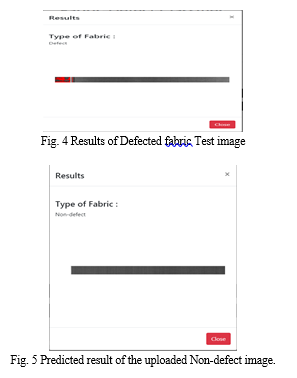
Conclusion
It becomes easy to see defects in an fabric using this method Monitoring one\'s vision is a tedious task that involves observing, paying attention, and attempting to accurately detect the occurrence of failure. In this paper we proposed the deep learning system which can detect tissue defects with greater accuracy and efficiency. In the textile industry, we can detect the damage in the real picture and we can repair the damage with the help of this advanced management systems model.
References
[1] Kumar and G. K. H. Pang, ``Defect detection in textured materials using Gabor filters,\'\' IEEE Trans. Ind. Appl., vol. 38, no. 2, pp. 425440, Mar. 2002. [2] W. K. Wong and J. L. Jiang, “Computer vision techniques for detecting fabric defects,” in Applications of Computer Vision in Fashion and Textiles, Elsevier, 2018, pp. 47–60 [3] A. Kumar, “Computer-Vision-Based Fabric Defect Detection: A Survey,” IEEE Trans. Ind. Electron., vol. 55, no. 1, pp. 348–363, Jan. 2008, doi: 10.1109/TIE.1930.896476 [4] O. Essi H. Laga, and C. Samir, “computerized detection and classification of manufacturing defects in metal boxes using deep neural networks,” PLoS ONE, vol. 13, no. 11, p. e0203192,Nov.2018,doi:10.1371/journal.pone.0203192. [5] R. Furferi and L. Governi, “Machine vision tool for real-time detection of defects on textile raw fabrics,” Journal of the Textile Institute, vol. 99, no. 1, pp. 57–66, Jan. 2008, doi: 10.1080/00405000701556426. [6] W. Ouyang, B. Xu, J. Hou, and X. Yuan, “Fabric Defect Detection Using Activation Layer Embedded Convolutional Neural Network,” IEEE Access, vol. 7, pp. 70130–70140, 2019, doi:10.1109/ACCESS.2019.2913620. [7] O. Russakovsky, J. Deng, H. Su, J. Krause, S. Satheesh,S. Ma, Z.Huang, A. Karpathy, A. Khosla, M. Bernstein “ImageNet Large Scale Visual Recognition Challenge” (2019) [8] Kaiming He, XiangyuZhang, Shaoqing Ren, Jian Sun “Deep Residual Learning for Image Recognition” (2015) [9] M. Artuso and H. Christiansen “Optimizing TCP for Cloud Based Mobile Networks” (2016) [10] Dr. M. Prasad, “JAFFE Human Face Expresions” JCRT | Volume 10, Issue 4 April 2022
Copyright
Copyright © 2022 Jyothi M R, Dr. M Prasad. This is an open access article distributed under the Creative Commons Attribution License, which permits unrestricted use, distribution, and reproduction in any medium, provided the original work is properly cited.
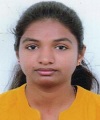
Download Paper
Paper Id : IJRASET45356
Publish Date : 2022-07-05
ISSN : 2321-9653
Publisher Name : IJRASET
DOI Link : Click Here
 Submit Paper Online
Submit Paper Online

